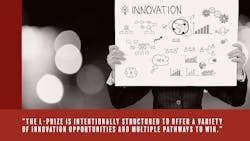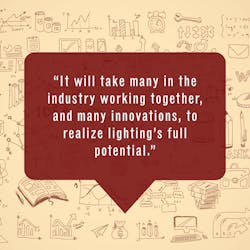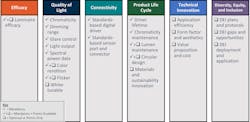As one of the architects of the L-Prize, I’m excited about all the innovation opportunities this prize offers to the lighting industry. The U.S. Department of Energy (DOE) created the L-Prize as one of several prize competitions in the American-Made Challenges platform. DOE uses these American-Made Challenge Prize competitions to inspire private sector innovation to address some of our nation’s greatest energy opportunities and challenges. There are prizes for solar innovations, more efficient electric cables, geothermal lithium extraction processes for batteries, and more. Here, with commercial lighting targeted by the L-Prize, the opportunity is to develop lighting systems that not only reduce energy use and carbon emissions, but also reduce the overall impact on the environment while making commercial buildings better places to work and occupy. We know lighting can do better and be better. The L-Prize challenges the industry to bring forward new innovations to realize the full potential of advanced lighting systems.
DOE structured the L-Prize in three different phases, each its own competition with unique goals and outcomes. The Concept Phase resulted in four winners announced in February 2022, and the next phase — the Prototype Phase — is now open. Anyone can enter; in fact, DOE invites, encourages, and welcomes new competitors in each phase. This current Prototype Phase contains two tracks: one for luminaires and the other for connected systems. A connected system is effectively a lighting control system. We invite all interested parties to submit working prototypes for either track. A total prize pool of $2 million for this phase will be split among up to six competitors across the two tracks.
Why will we allow up to six winners for the Prototype Phase? We want to encourage and recognize more than one innovation. It will take many in the industry working together, and many innovations, to realize lighting’s full potential.
The L-Prize is intentionally structured to offer a variety of innovation opportunities and multiple pathways to win. Yes, we have included a set of baseline requirements for each track: Participants will need to provide a minimum level of performance in areas including efficacy, quality of light, connectivity, and component lifetimes in the luminaire track. These are represented by the checkmarks in Fig. 1. But it’s really the open checkboxes in this figure, representing innovation opportunities, that will win the competition.
Here you can earn points in many different areas, and they are entirely optional, in some cases even open-ended, encouraging competitors to propose new innovations to DOE in areas we may not have considered. These optional points opportunities invite innovations to address some of the most pressing technical opportunities and challenges for the industry.
Following are some exciting examples of the innovation opportunities within the Luminaire Track.
Circular design — Up to 8 points can be earned for circular design innovations that extend useful lifetime, reduce the use and extraction of harmful materials, and/or decrease operational and embodied carbon impacts using modular design approaches.
Materials and sustainability innovation — Up to 10 points can be earned for innovation that improves material transparency or reduces the use of harmful materials or manufacturing processes.
Application efficiency — Up to 5 points can be earned for innovations that improve in-application efficiency beyond efficacy, such as improved optics/distribution that better distributes light while increasing comfort and/or reducing discomfort glare.
Form factor and aesthetics — Up to 5 points can be earned for innovations in form factor and/or aesthetics that can improve the acceptability or adoptability of a luminaire.
The Connected Systems track presents a similar scenario — some mandatory minimums in several areas of Connectivity, and then the optional open checkboxes that will earn points and help win the competition, as shown in Fig. 2. These opportunities address some of the most pressing technical challenges and prospects for advances in the industry.
Ease of installation and use — Up to 5 points can be earned for innovations that simplify or improve the ease of installing, configuring, operating, and/or maintaining connected lighting systems.
Compatibility and interoperability — Up to 5 points can be earned for innovations that improve the compatibility and/or interoperability of connected lighting systems with other lighting or non-lighting devices and systems in a building.
Value proposition and cost — Up to 5 points can be earned for innovations that reduce the cost, improve the cost-effectiveness, and/or improve the value proposition of connected lighting systems.
Life cycle and sustainability innovation — Up to 10 points can be earned for connected system innovations that support positive environmental impacts, such as improved product circularity, end-of-life outcomes, reductions in use and extraction of harmful materials, or improved material transparency.
Up to 15 points are available in each track for diversity, equity, and inclusion (DEI) practices or policies that acknowledge the diverse makeup within participating teams and in the communities that will benefit from resulting innovations, including communities that have been historically disadvantaged. Many prompts and suggestions have been provided on possible DEI approaches in the L-Prize Official Rules Document.
The structure of this L-Prize competition offers so many different ways to win, it makes me excited to see what today’s bright minds in lighting will deliver. Who are the industry leaders? What improvements will they bring? As I said upfront, we know lighting can be better. The L-Prize has thrown down the gauntlet to all interested parties: Let’s unlock lighting’s full potential. The Intent to Submit deadline is approaching on January 13, 2023, with submissions due on May 1, 2023. Let’s see your innovations!
L-Prize Deadlines: Things to know & what to do
♦ The L-Prize Prototype Phase opened in June 2022 and as stated above the intent to submit deadline will be January 13, 2023. Entrants are not required to participate in the prior Concept Phase in order to submit a prototype to the L-Prize program.
Visit the L-Prize website and register on the HeroX platform. Click on “Solve this Challenge” and accept the competitor agreement in order to access the full capabilities of the website.
Click on “Begin Entry” and complete the Intent to Submit form, providing a brief description of your intended luminaire or connected system. You do not need to have your complete submission package ready at this time. The complete submission package is due in May 2023; see the L-Prize Official Rules linked above for more details.
Still have questions after reading the L-Prize rules? Check out the HeroX Forum Q&A then email [email protected] for further assistance as needed.
♦ The public comment period for the Manufacturing and Installation Phase requirements also closes on January 13, 2023. DOE will evaluate entries in the final L-Prize phase for technical performance and innovation attributes, U.S. manufacturing opportunity, deployment strategy, and installation models. Up to four competitors will share an award of $10 million. Share your input on the requirements by completing the Comment Form on the L-Prize website.
Get to know our expert
GABE ARNOLD is a senior engineer at Pacific Northwest National Laboratory (PNNL), which provides technical support for the L-Prize competition. Arnold focuses on development and deployment of emerging lighting technologies as a principal investigator on the PNNL advanced lighting team supporting the U.S. Department of Energy’s Lighting R&D and Commercial Buildings Integration programs.
For up-to-the-minute LED and SSL updates, follow us on Twitter. You’ll find curated content and commentary, as well as information on industry events, webcasts, and surveys on our LinkedIn page and our Facebook page.









